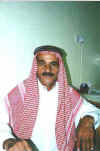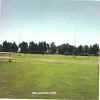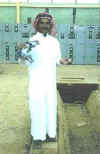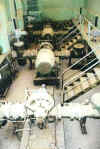|

    
On the morning of the 12th, the driver
who was to drive me along the pipeline arrived. He was a pleasant
Indian fellow and the car looked like a 1984 Chevrolet, one that had seen
several years of Tapline service. We departed and after only a few minutes I discovered that the driver did not
speak Arabic nor English so that promised it would be a quiet trip. I also did
notice that he was not very much at ease in the busy traffic of Dammam.
We reached the main road to Kuwait and a few kilometers after passing
Qatif
Oasis,the above ground stretches of Tapline on the left side of the road as well as the
first overhead road signs pointing the way to the old dirt road along the
pipeline.
above ground stretches of Tapline on the left side of the road as well as the
first overhead road signs pointing the way to the old dirt road along the
pipeline.
After about 15 kilometers we passed Tufiah which is an
electric boosterpump
station in the Aramco section of Tapline. 
The next landmark was the turn -off to Nariyah where we stopped for fuel and
since the temperature had been rising quite steadily, for a cool drink. The gas
station where I used to stop for fuel so many years ago was still there and did
not appear to have changed or improved a great deal. Inside the
"Restaurant" I met a nice gentleman who invited me to share his lunch,
which I politely declined. His name was Mr. Khan and he was the manager of the
place. He wanted to know where I came from and what I was doing in the
area. I told him that back in the 80's I used to drive from Turaif to
Dhahran and back and I used to fill up at this same station. He did tell me
about the horrific traffic on the road during the Gulf crisis and the many
accidents that happened. manager of the
place. He wanted to know where I came from and what I was doing in the
area. I told him that back in the 80's I used to drive from Turaif to
Dhahran and back and I used to fill up at this same station. He did tell me
about the horrific traffic on the road during the Gulf crisis and the many
accidents that happened.
We then departed on the way to Qaisumah. Not much change in the scenery but I
was getting uneasy about my driver. He had a very heavy foot, the one on the
accellerator, and he was driving consistently over 120 Km/h. Not a high speed by
any standard but as soon as he drove over 100 Km/h. the air conditioning would
quit. So I had to remind him to slow down a bit. All I got in the way of
acknowledgement was a big grin, so when I found out that it would
not make a bit of difference, I just let him do his own thing.
  Aramco removed the Wariah turbine in 1984 and they did a very good job of
cleaning up, much better than the removal crews who removed the Tapline APU
turbines. Only the
concrete foundations are left and not much else. The Microwave facilities have
expanded and are located where the generator building used to be. Aramco removed the Wariah turbine in 1984 and they did a very good job of
cleaning up, much better than the removal crews who removed the Tapline APU
turbines. Only the
concrete foundations are left and not much else. The Microwave facilities have
expanded and are located where the generator building used to be. We had progressed to about 25
Kms. beyond Wariah when I heard a familiar loud
thud. About 30 seconds later another louder one and I told the driver to
stop. I had heard this type of sound a few times in the old days and it usually
meant that the sole of a tire was coming off.
Sure enough, the left front tire
had shed about half of it. So out came the jack. The driver did not have a clue
where to place it so I pointed to the jack plate under the chassis. The driver came up with a cross type lug wrench, the one with a different size
socket at each of the four ends. These ends are too large to fit in the jacking
socket so the search was on for the original jack or something that would be small and strong enough
to operate the jack. The driver did not have a clue what I was on about. I
emptied the trunk contents on the ground, massive amounts of dried and canned
food, bed rolls and what have you. Finally in the bottom of the tire well on the
left side I found the original lug wrench buried in all kinds of rubbish and we managed to change the tire. These ends are too large to fit in the jacking
socket so the search was on for the original jack or something that would be small and strong enough
to operate the jack. The driver did not have a clue what I was on about. I
emptied the trunk contents on the ground, massive amounts of dried and canned
food, bed rolls and what have you. Finally in the bottom of the tire well on the
left side I found the original lug wrench buried in all kinds of rubbish and we managed to change the tire.
My major concern was to get to Qaisumah without any further flat tires and to purchase a new tire. However
Qaisumah is still as big (or small) as it was in the old days, the gloss having
been taken by Hafar Al-Batin. The Qs pumpstation industrial area is still
complete,
see the pictures.
The housing area is used by the military which prevented me
from entering the station, however I did take some pictures from outside the
fence.




  
I did notice when we drove towards Hafar that just before the turn-off the
old waterwell with the house and a few trees on the right side of the road where
in the old days water tankers used to get their water, is still there !
Hafar which I remember as a small mostly
mud brick town, built around the old castle has really grown in all directions
extending along the pipeline road and south of it in the direction of King
Khalid Military City. And it even boasts a
proper Holiday Inn hotel ! We had
problems trying to find the right tire but after a few tries we finally found
one. We also had an "expert" look at the failing AC but instead he
managed to do something so that the car would not start. Another hour later that
starting problem was solved, so I decided to remove my destiny off the hands of
the Turkish ?? "mohendes " and depart without
AC.
It was close to 5 pm. and we had not eaten anything of substance. Just north
of the Tapline road crossing was an impressive looking place. I took a look at
the menu and decided that my best option was to drink a Pepsi. The staff was all Egyptian,
they were very pleasant and I think somewhat taken back to see a foreigner and
hear him speak Arabic with a Dutch accent !. One of them spoke good English and
I learned that since the Gulf war not many westerners came to Hafar. He nor any
of the other people had ever heard the name Tapline. I put the same question to
the people at the tire shop as well as the garage and only one of the few Saudi nationals
at the tire shop knew about Tapline, as all the others were of different
nationalities so the result is not surprising. So loaded with a new spare but
with an empty stomach we continued our journey to Rafha.
Arrived in RAfha just before sunset and started to look for a hotel. The
driver was going to stay in the small Al-Mohanna compound. I found a small decent
looking hotel "Ali Baba" just before the Tapline gate and
discovered that its owner was
none other that our ex Office Specialist Mohammad Qublan ! Qublan has always had a very unconventional outlook on life and is a philosopher of sorts.
In the old days we used to have long conversations and it was quite apparent
that he was a very keen observer of the world not just around him, but of the
world in general. Most interesting of all is that he draws some very interesting
conclusions. He came over to see me after evening prayers and we talked
until late at night. He told me about the very good business he did before the
Gulf war as some of the French officers were staying at his hotel.His staff is all Egyptian and they came up with a very enjoyable meal. The
rooms were large and clean. After a refreshing shower I went to bed and slept like a log. The next morning after breakfast
Qublan came to show me around Rafha. I walked out the door and faced a
large green area which reminded me of John Arnold who unconventional outlook on life and is a philosopher of sorts.
In the old days we used to have long conversations and it was quite apparent
that he was a very keen observer of the world not just around him, but of the
world in general. Most interesting of all is that he draws some very interesting
conclusions. He came over to see me after evening prayers and we talked
until late at night. He told me about the very good business he did before the
Gulf war as some of the French officers were staying at his hotel.His staff is all Egyptian and they came up with a very enjoyable meal. The
rooms were large and clean. After a refreshing shower I went to bed and slept like a log. The next morning after breakfast
Qublan came to show me around Rafha. I walked out the door and faced a
large green area which reminded me of John Arnold who constructed the first
(part of) a green golf course in Saudi Arabia ! The
next picture is a view from the main gate looking towards the east, on the left is the small hill that faces
the gate. The white cars are parked opposite Qublan's Ali Baba hotel, the PL
road was straightened and is on the far right, yes lined with trees as far as
the airport and the trees straight ahead are around the Traffic Police station. constructed the first
(part of) a green golf course in Saudi Arabia ! The
next picture is a view from the main gate looking towards the east, on the left is the small hill that faces
the gate. The white cars are parked opposite Qublan's Ali Baba hotel, the PL
road was straightened and is on the far right, yes lined with trees as far as
the airport and the trees straight ahead are around the Traffic Police station.
We drove into Rafha, which is in sharp contrast to what it used to be. The
streets are wide and well paved. We soon met up with two ex employees, Matrouk
Sayed, ex Community Maintenance Foreman
and Suleiman Saleh,  ex RafhaDiesel Mechanic. The timing of my trip was unfortunate as many of the ex employees are still
living in Rafha but in July usually go away to visit their children elsewhere
in the Kingdom or travel to Jordan or Syria for the summer. The town has grown
tremendously and was quite impressed with the general appearance of it all.
ex RafhaDiesel Mechanic. The timing of my trip was unfortunate as many of the ex employees are still
living in Rafha but in July usually go away to visit their children elsewhere
in the Kingdom or travel to Jordan or Syria for the summer. The town has grown
tremendously and was quite impressed with the general appearance of it all. Abdel
Latif al-Ruwaili arrived who is the General Foreman in the present
organization, he has the keys to the station and was going to show me around. We
drove first to the housing area, where only the CC Building is still standing
and was used by the coalition forces during the Gulf campaign. In 1998 the
dozers moved in and removed all houses, bunkhouses and most trees. Here are two
pictures of the housing area both taken from the far end of the street, one taken in 1968,
the other one taken in July 2001.
The difference is obvious and it brings back many memories of the people who
lived there. The same is true of course of the rest of the stations. 
 Rafha
boasted a green golfcourse built by John Arnold with help of the station
residents and his sons whenever they came over. The other two pictures are of
Rafha Main Street. The green one taken in 1968 taken from the corner of the C.C.
Building, the other one taken in 2001 from the opposite direction. Rafha
boasted a green golfcourse built by John Arnold with help of the station
residents and his sons whenever they came over. The other two pictures are of
Rafha Main Street. The green one taken in 1968 taken from the corner of the C.C.
Building, the other one taken in 2001 from the opposite direction.
The pumphouse now stands empty, all engines, cooling water pumps, generators, compressors,
finfans and other equipment was removed only the switchgear is left behind.  Now there are plenty of wild pigeons nesting inside the building and Qublan came
back within minutes with two live
Now there are plenty of wild pigeons nesting inside the building and Qublan came
back within minutes with two live  pigeons and one egg, for his son, so he said.
This picture shows Abdel Latif standing on the foundation rails of C
generator.
The new AC plant that was moved from inside the pumphouse to outside in 1982 has
been removed.
pigeons and one egg, for his son, so he said.
This picture shows Abdel Latif standing on the foundation rails of C
generator.
The new AC plant that was moved from inside the pumphouse to outside in 1982 has
been removed.
The horizontal booster pumps
are still there covered with pigeon droppings.
 The incoming line valves and vertical booster pumps etc. are all intact.
The incoming line valves and vertical booster pumps etc. are all intact.
Note
the trees and shrubs along the PL road. The 600HP electric booster
pumps look like they were installed a few days ago !




The
hospital looks a bit deserted as of course it is !
We had spent a considerable time just looking around, now was the time to
continue my trip to Badanah. I said Goodbye to Qublan and Abdel Latif but
before getting in the car, I walked a few hundred yards up the road and
had a look towards Rafha Pumpstation. I thought of a man who loved a green station. 




Home Page
Top
of Page
Next Page
|